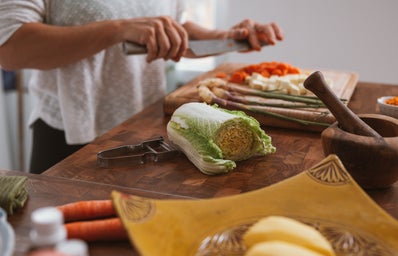Since I was a kid, I was always strangely intrigued by cooking, because if you really think about it, cooking is just like edible alchemy—ingredients transform before your eyes into something wonderful. However, I understand that many people my age don’t share the sentiment. I get it, but due to our circumstances as students, perhaps you’ve reluctantly started learning how to cook because you want to save money on food. For some of us, maybe we do find cooking a wonderful thing, but we don’t know where to start. In that case, this mini guide has got you covered with simple yet delicious recipes for you to practice and build up your confidence with.
As a disclaimer, I’m not a chef, and the recipes are based on my experience (which means I don’t use accurate measurements 100% of the time). Additionally, most of the recipes are in the Chinese style (because of my own background) so I apologise in advance if these seem quite restrictive as a result!
FYI, these recipes are generally for one serving, but can be adjusted accordingly with the portions you usually eat/carbohydrate intake. They also require quite a few household staple ingredients (various oils, condiments, ingredients), so you might have to share these with your friends if they are also cooking often.
1. Steamed Eggs
Ingredients:
- 2-3 eggs (depending on the size of the eggs and how much you eat)
- Broth of choice (I usually use chicken, but can be substituted for vegetable broth)
- ½ teaspoon soy sauce
- White pepper
- ½ teaspoon White vinegar
Equipment:
- Strainer
- Steamer
Instructions:
- In a bowl, crack the eggs in and whisk lightly. Try to keep your fork/chopsticks/whisk in contact with the bottom of the bowl while mixing and try not to incorporate too much air into the mixture
- To this, add in your broth of choice. The amount of broth added should be approximately twice the volume of the eggs.
- Add in your soy sauce, vinegar and a sprinkle of white pepper. The vinegar will help to ensure that your steamed eggs turn out silky. Mix well (and lightly!)
- After mixing, strain your mixture into your steaming bowl and discard the egg curds stuck in the strainer. If you don’t have a strainer at home, skipping this step is also possible but the eggs will not turn out super silky.
- In a pot (with a lid and your steamer), bring some water to a boil (the water level should be slightly lower than the base of the steamer).
- Once it starts boiling, place the egg mixture onto the steamer and cover the pot, leaving the egg to steam for around 15-20 minutes on low heat (crucial to ensure that the egg stays silky). After that, it is ready to serve with rice!
With these eggs, for some extra flavour, you can top them off with some chopped spring onions and some sesame oil. If you’re feeling more adventurous, you can even add seasoned minced meat or mushrooms into the egg!
2. Fried eggs
Ingredients:
- 2 eggs
- 2 tablespoons of milk or water
- 1 teaspoon of soy sauce or ½ teaspoon of salt
- 2-3 mushrooms (shiitake or brown)
- ¼ Bell pepper
- ¼ onion
- 1 slice of ham (optional)
Instructions:
- Crack the 2 eggs into a bowl and beat them with a fork.
- Combine the soy sauce or salt and milk with the eggs.
- Thinly slice your mushrooms and chop your onions, bell pepper and ham finely.
- Incorporate your ingredients with the egg mixture, stirring to combine.
- Heat up a non-stick pan with your preferred oil of choice (butter also works), and test the heat of the pan with a drop of the egg mixture. If it starts to fry (and not burn or smoke) upon contact with the pan, add the rest of the mixture to the pan, spreading the ingredients out evenly.
- Fry the egg on medium heat, waiting until the sides of the egg turn golden brown. If it is ready to flip, the egg should easily detach itself from the bottom of the pan.
- To flip the egg easily, take a plate similar to the size of the pan, cover the pan with it and flip the pan onto the plate. Then, gently slide the egg back onto the pan.
- Let the egg fry for another 1-2 minutes, transfer it to a plate and it is ready to eat!
3. Stir Fried Bok Choy with Garlic
Ingredients:
- 1 bok choy cluster
- 2-3 cloves of garlic
- 3-4 tablespoons of water
- Soy sauce or Salt or 1/2 Bouillon cube (I recommend chicken, but vegetable also works)
Instructions:
- Chop off the stem of the bok choy (the thick, bottom part holding all the bok choy sections together.
- Rinse the bok choy well, then set aside.
- Crush then peel the garlic cloves. If you want, you can slice or mince the garlic. Otherwise, throwing in the whole clove is also fine.
- Heat up the pan with a neutral cooking oil (sunflower, vegetable, rapeseed etc.), and once the oil starts bubbling slightly add the garlic in.
- Fry the garlic on medium heat until almost golden brown, then add in the bok choy.
- If you are seasoning the bok choy with soy sauce, add it into the pan with the water. Otherwise, dissolve half a bouillon cube in 4 tablespoons of hot water. Once dissolved, add into the pan.
- Fry on medium heat until the bok choy looks cooked (the leafy portion turns soft and dark green). This should take about 3 minutes. Once cooked, it is ready to be plated and paired with your carbohydrate of choice (rice or noodles).
- Optionally, you may add some sesame oil over the cooked dish to give it more fragrance.
The bok choy in this dish can be replaced with other vegetables such as broccoli, kangkong, spinach, chye sim etc. You can even do a mushroom version of this dish with an assortment of Japanese mushrooms!
4. One pan Mushroom Aglio Olio Pasta (not traditional)
Ingredients:
- 4 garlic cloves
- 5 medium sized mushrooms
- Pasta (as much as you eat)
- Olive oil
- Salt
- Italian herbs
Instructions:
- Peel your garlic and thinly slice them. Slice your mushrooms and set aside.
- In a pan, heat up some olive oil (don’t skimp on the olive oil, pour enough to almost cover the base of the pan). Don’t heat the pan on high heat because your garlic will burn.
- Add your garlic into the pan, and fry it for about 8 minutes on medium low heat. Don’t rush the process–the extra time is needed to bring out the flavour of the garlic.
- Once your garlic turns light golden brown, add in your mushrooms and stir fry on medium heat until they start browning.
- Now, add your pasta into the pan and pour enough water into it to cover the pasta.
- Turn the heat to high, and once the pasta starts boiling, turn the heat down to medium. Following the instructions on the pasta packet, set a timer for the instructed time.
- Stir the pasta as it boils, making sure that it does not stick to the bottom. If the water seems to be boiling away too quickly (disproportionately earlier than the time left on the stopwatch), add water bit by bit to ensure that the pasta does not dry up too much.
- Once the time is up, sprinkle some italian herbs on the pasta and stir to combine. If the pasta is still too hard for your liking, add a bit more water and let it go for 1-2 minutes longer. Once done, it is ready to serve.
If you prefer, you can also add other ingredients such as ham, bell peppers or zucchini to it. In this video by Gabie Kook, while not exactly an aglio olio, she adds in shrimp and tomatoes.
5. Tomato rice
Do note that this makes more than one serving, at least for me.
Ingredients:
- 1 large ripe tomato or 2 small ripe tomatoes
- 2 cups of rice
- 1 tablespoon of butter (alternatively, use 2 teaspoons of olive oil)
- 1-2 cloves of garlic, thinly sliced
- 1 cup of water
- 3 cups of broth (chicken or vegetable also works)
- 1/2 teaspoon salt (use 1 tsp instead if you are not using broth)
Equipment:
- Rice cooker
Instructions:
- Wash your rice, then add the water and broth to it.
- Cut off the stem of the tomato, then place the whole tomato into the rice cooker
- Add your salt and garlic into the pot.
- Begin cooking the rice in the rice cooker, and once the time is up, mash and mix the tomato into the rice and serve.
Like many of the aforementioned dishes, you can customise your rice by adding more ingredients. You could add chopped, dried shiitake mushrooms (replacing some of the water with the water you soaked the mushrooms in for extra flavour), ginger, various meats, diced carrots and so on! In this video by Strictly Dumplings, he adds in a variety of ingredients like trumpet mushrooms, roasted pork (which you can easily substitute), pickled radish, scallions and chilli oil (at the end!).
Apart from the recipes mentioned above, if you’re a busy student (or just want to cut down on the effort needed to cook), you could try your hand at meal prepping, which involves either preparing the key elements in a dish all at once or cooking a large portion of the dish to portion out and eat later. Buying versatile ingredients such as chicken breasts, eggs, avocados, bell peppers, mushrooms etc. also ensures that you can cover (because honestly, we get sick of eating the same thing for 3 days straight) a variety of dishes from different cultures with minimum expenses. I find the video by Downshiftology to be quite useful in this respect, and Tasty’s list of one pot recipes helpful, simple and inspiring.
I highly recommend cooking, especially for those of us who want to cut costs and save some money! It’s a break from schoolwork, and for all you know, it could be your new passion or hobby. So, don’t be afraid to try! We all have to start somewhere, and hopefully this small guide will give you the lift off you need to start cooking and experimenting in the kitchen!


